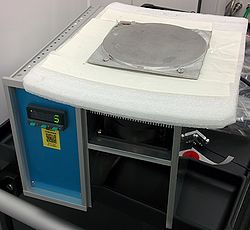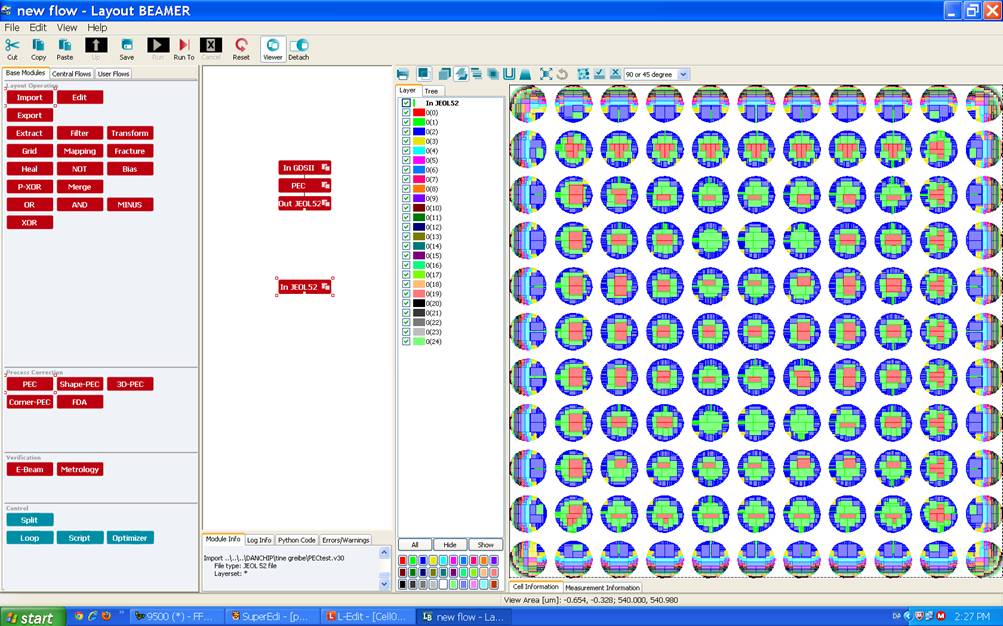Specific Process Knowledge/Lithography/EBL: Difference between revisions
No edit summary |
No edit summary |
||
| Line 105: | Line 105: | ||
= Spin coating and resist information = | = Spin coating and resist information = | ||
Information on spin coating of EBL resist is '''[[Specific_Process_Knowledge/Lithography/EBL/EBLresist available here.]]''' | Information on spin coating of EBL resist is '''[[Specific_Process_Knowledge/Lithography/EBL/EBLresist|available here.]]''' | ||
Revision as of 13:47, 18 March 2022
Feedback to this page: click here
Introduction to E-beam lithography at DTU Nanolab
DTU Nanolab has two E-beam writing systems, a JEOL JBX-9500 FSZ and a Raith eLINE Plus. Newcommers to EBL should start by watching our JEOL 9500 process video to see how a typical process is done. The Raith eLINE Plus is not operational yet, we expect to release it Q3 2022.
Compared to UV lithography EBL is somewhat more complicated and in general a significantly longer process. Writing time (per area) is much higher and thus EBL is only adviseable for structures with Critical Dimensions (CD) below 1 µm. For CD equal to or higher than 1 µm please consider our Maskless Aligner tools.
A typical EBL process will involve the following steps:
- Spin coating and soft baking of EBL resist
- Application of a discharge layer for non-conductive samples or samples with >200 nm insulating films
- Proximity Error Correction of design
- Splitting design into low current (fine detail) and high current (bulk) parts to reduce writing time
- Job file creation to define exposure parameters
- Sample mounting
- EBL calibration and beam optimization
- Exposure
- Discharge layer removal (if applied)
- Resist development
Guidelines and process information on all of these steps are available from links on this page.
A quick comparison table between our two EBL systems is provided below to help assess which tool is best suited for your process. Please contact our EBL staff if you have any questions regarding the two tools or which one is best suited for your process.
| Equipment | JEOL JBX-9500FSZ | Raith eLINE Plus | |
|---|---|---|---|
| Performance | Resolution | 7 nm (HSQ) | 8 nm |
| Maximum writing area without stitching | 1mm x 1mm | ? | |
| Process parameter range | E-beam voltage | 100 kV | 1-20 kV |
| Scanning speed | 100 MHz | ? | |
| Min. electron beam size | 4 nm | 2 nm | |
| Min. step size | 1 nm | ? | |
| Beam current range | 0.1nA to 60nA in normal conditions | ? | |
| Dose range | 0.001 - 100000µC/cm2 | ? | |
| Samples | Batch size |
Wafer cassettes:
|
? |
| Substrate material allowed |
Any standard cleanroom material, except materials that will degas and special treatment for graphene |
Any standard cleanroom material, except materials that will degas and special treatment for graphene | |
Training in E-Beam Lithography
Please request training in E-Beam lithography by sending an email with your process flow to e-beam@nanolab.dtu.dk.
Spin coating and resist information
Information on spin coating of EBL resist is available here.
Development
There are many different developers for different E-beam resist, but since CSAR and ZEP520A are the most used at Nanolab, we have installed a semi automatic puddle developer: Developer E-beam in E-4.
To accommodate most users, this tool uses developers: AR 600-546 for development of CSAR 6200 resist series and ZED N-50 for ZEP520A resists and IPA as a rinsing step.
Intermediate results indicate that using ZED N-50 for CSAR 6200 series resist will introduce an elevated amount of residues, and vice verva for AR 600 - 546 used on ZEP 520A, but it is inconclusive.
We therefore recommend to use:
- ZED N-50 for Zep520A
- AR 600-546 for CSAR 6200 series
The recipes are divided into different developer and development times.
The recipes 546 are short for AR 600-546 and N-50 is short for ZED N-50.
After the developer there is a time indication eg. 10s, 30s, 60s ect.
Since this system is a spray nozzle that creates a puddle of developer on the substrate the spray is on for 10s. to cover any type of substrates, however this procedure starts the actual development, and the "idle" time is hence shortened accordingly.
The system is setup so that 10s. in the Developer E-beam correlates to 10s. in a beaker, however all designs are different and larger or smaller structures may need different development times.
Cold development

We do have the possibility of making cold development, to get more vertical and smoother sidewalls. We have a coolplate that can go down to -2°C, with a ramp of app. 3 °C/min.
Is it recommended to make a dose test, if one is to transfer from ordinary development to cold.
Procedure
- Pour developer suited for your resist into a small blue cap bottle, and label it, remember to mark it with lot number, date and your name.
- Leave this small bottle of developer in the fridge in Cx1 at least overnight to acclimatize.
- Take the coolplate located in D3 (see picture) and connect it in Fumehood 10 (E-beam) place it on the sink-lid to keep a good airflow.
- Hold left button on the front panel of the cool plate and set temperature with up/down arrows.
- The cool plate can go down to -2°C, and the fridge is +5°C hence use a beaker and pour cold developer into it and place on the coolplate, leave it to acclimatize for the desired temperature.
Development time in cold development, should be subject to testing, depending on structure size and density, but is comparable with "normal" development times.
When developing at low temperatures, condensation can occur
Remember to clean up after you are done
Proximity Error Correction
Even though the electron beam diameter is below 5 nm, the feature and pitch resolution in resist is limited by the forward and backward scattering of the electrons. The forward scattering depends on the electron acceleration voltage, the resist material and thickness. The backward scattering depends on the electron acceleration voltage and the substrate material [1], [2].
As the travel distance of backscattered electrons is fairly large, e-beam patterned structures will be influenced by adjacent e-beam patterned structures, i.e. a proximity effect. These proximity effects can be avoided either by simulating a proximity error correction (PEC) in BEAMER or by using the right stack of e-beam resist.
Proximity Error Correction (PEC) in BEAMER

BEAMER is endowed with a software that corrects for proximity errors in the e-beam exposure. You can read more about this function in the BEAMER manual here and in the BEAMER presentation here BEAMERPresentation.pdf.
The proximity error correction require a forward and a backward range parameter, alfa and beta, and a ratio of backscattered energy to the forward scattered energy, eta. As alfa depends on the electron acceleration voltage, which is constant at 100kV, alfa is in BEAMER fixed to 0.007. Help to find beta and eta can be found here.
Alternatively, a point-spread function can be used in BEAMER to calculate the optimised dose-variation.
Trilayer resist stack
As an alternative to PEC, a trilayer reists stack with a thin layer of thermally evaporated Ge can be used [3]. This reists stack has not yet been tested at DTU Nanolab. A process flow for this procedure can be found here Process_Flow_Trilayer_Ebeam_Resist.docx, but please contact Lithography before use.
Charging of non-conductive substrates
All substrates are grounded to the cassette when properly loaded. In a non-conducting substrate, the accumulation of charges in the substrates will however destroy the e-beam patterning. To avoid this, a charge dissipating layer is added on top of the e-beam resist; this will provide a conducting layer for the electrons to escape, while high-energy electrons will pass through the layer to expose the resist.
If you wish to investigate the charge dissipation using other methods than below, please contact Lithography.
ESPACER
Espacer is a chemical that works as a discharging layer; it is spun onto the wafer on top of the resist and easily rinsed off the wafer after e-beam exposure. Visit this page for more information: Espacer
Aluminum coating
At DTU Nanolab, we recommend to use a thin (20 nm) layer of thermally evaporated aluminum on top of the e-beam resist. Preferably, the thickness of Al and the e-beam dose should be optimised to the features you wish to e-beam pattern [4]. A good starting point is 20 nm Al; from here dose and development can be optimised to reach the resolution and feature size required.
The process flow for a standard e-beam exposure on CSAR with Al on top can be found here Process Flow CSAR with Al.
Literature on E-beam Lithography
- Handbook of Microlithography, Micromachining, and Microfabrication, Volume 1: Microlithography, P. Rai-Choudhury (Editor), chapter 2 (p 139 – 250). Link to book can be found here: http://www.cnf.cornell.edu/cnf_spietoc.html
- Lithography, Wiley, 2011: Chapter 3, Electron Beam Lithography by Stefan Landis: http://onlinelibrary.wiley.com/doi/10.1002/9781118557662.ch3/summary
